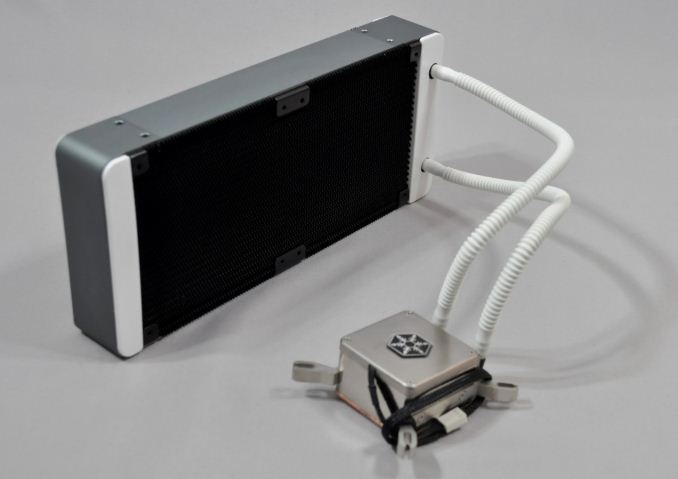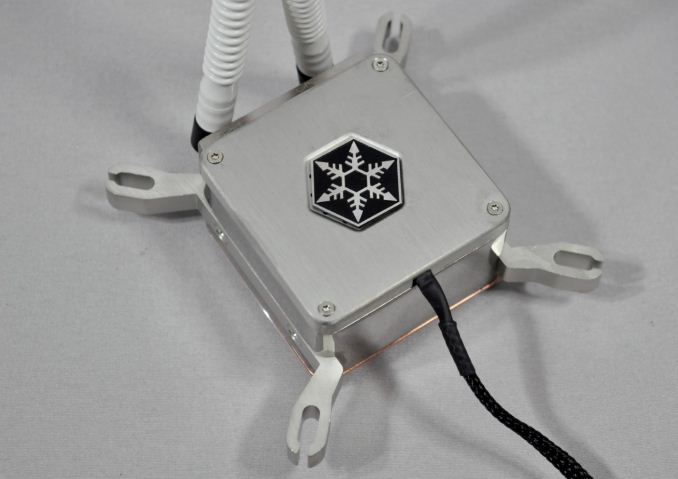Closed Loop AIO Liquid Coolers: 14-way Mega Roundup Review
by E. Fylladitakis on February 12, 2014 7:00 AM ESTSilverstone
Silverstone is another well-known name amongst advanced users and enthusiasts. The company earned their reputation from their first PSUs and original case designs and soon diversified towards cooling related products. They currently offer just two AIO liquid cooling solutions, the Tundra series. The company shipped both of them to us for this review.
Silverstone Tundra TD02
Silverstone ships the Tundra TD02 inside a large cardboard box with a black/blue theme. The box has plenty of pictures and information about the cooler printed on all of its sides. The company also supplies a fairly standard bundle with the Tundra TD02, which consists of a manual with installation instructions, mounting hardware and a syringe with thermal compound. There also is a 3-pin Y-splitter fan cable included, which can be used to power two fans off a single header. Silverstone supplies two 120mm fans with the TD02. The fans have back frames and curved, notched white blades that supposedly reduce aerodynamic noise, as well as fluid-state bearings for prolonged life. Their speed range is rather narrow, ranging from 1500 to 2500 RPM.
Visually, the Silverstone Tundra TD02 certainly stands out a lot. Although it is somewhat different, the Tundra TD02 could be coming from the same OEM that makes the Enermax Liqtech 120X as well; however, Silverstone did not want to reveal their source. The very large and deep radiator with the grey aluminum frame stands out, the size of which overwhelms any Asetek/CoolIT design. Size is not always a good thing though, as the 45mm thick design could bring serious compatibility issues, especially if the case has been designed with 27-29mm radiators in mind.
The design of the radiator is quite different from that of most other kits. Like the radiator of the Liqtech 120X, instead of wavy aluminum fins between the liquid pass-through channels, this design forms single, "seamless" fins from one side to the other, which are soldered onto the channels. The design of the fins and the overall size of the radiator though is different.
The block-pump assembly of the Tundra TD02 stands out over that of most other kits as well. It is entirely metallic, made of nickel-plated aluminum with a copper base. A badge with Silverstone's logo lies in the middle of the aluminum cap, which also has very subtle blue LEDs surrounding it. There is something unique about this block however; unlike any other assembly, including that of the Liqtech 120X, the copper base of the block is not attached to the assembly with screws, leaving the bottom of the block entirely plain. It has also been machined down to a perfect, smooth finish. The only thing that we could complain about is the use of narrow, stiff, white corrugated tubing, which is beneath the quality of such a product.
Silverstone Tundra TD03
Confusing as this may be, the Tundra TD03 actually is a smaller version of the TD02. It comes in a similarly designed cardboard box with a black/blue color theme, only it's significantly smaller. Despite the change in size however, the cooler remains very well protected within cardboard packaging and inside nylon bags. It also shares exactly the same bundle with the TD02, including the manual with the installation instructions. The two 120mm fans supplies are the same as those of the TD02, with a black frame and curved, notched white blades.
Both visually and practically, the Tundra TD03 is just a shorter version of the TD02. The radiator also shares the same design, and is just as wide and thick as the radiator of the TD02, yet nearly half as long, which means that it essentially has half the heat dissipation surface. Nevertheless, Silverstone still supplies two 120mm fans, to be used in a push-pull configuration. It is interesting to note that this radiator design appears a lot more solid, without any imperfections or bent fins, which appear to be very common on radiators with wavy aluminum fins.
As expected, the fully metallic block-pump assembly of the Tundra TD03 is identical to that of the TD02. The top and frame of the assembly are made out of nickel-plated aluminum, with the base of the block made out of solid copper. Even the mounting braces are made of solid aluminum, with those meant for Intel CPUs preinstalled on the block from the factory. Once again, the copper base is not attached to the aluminum frame with screws, at least not screws visible from the bottom of the assembly, leaving the base of the cooler perfectly clean and smooth.
























139 Comments
View All Comments
BlakKW - Friday, February 14, 2014 - link
Nice round-up E.Fyll...congrats on your new spot. Its a fine line between answering questions in the Comments section, and getting sucked into it...be cautious :)MushroomBomb - Friday, February 14, 2014 - link
Disappointed not seeing any Thermaltake Water, especially with their 3.0 offering, pretty sure they would be able to compete here.Bap2703 - Tuesday, February 18, 2014 - link
One should take care that the testing setup is in no way providing a "core" temperature despite being written on every graph :/aggiechase37 - Friday, February 21, 2014 - link
I've had the stock Intel fan on a 4770, and was getting temperatures in the 90's while rendering video. Thanks to this article, I've got the Corsair h90 on the way. Thanks guys!Valentini - Saturday, December 20, 2014 - link
Finally a truly meaningful test (the best test I have ever seen). In particular, indication of the thermal resistance is really great. The whole thing would be a little bit more accurate, if the indication of differences in temperature would be written in Kelvin instead of Celsius.pikunsia - Wednesday, August 5, 2015 - link
The difference in Kelvin (absolute) and Celsius (relative), as well as in Rankine (absolute) and Fahrenheit (relative) are the same! my friend. Please, let me show you, taking for example Celsius-Kelvin. Let T_C, T_K be temperatures in Celsius and Kelvin respectively. Thus,T_K1 = T_C1 + 273.15,
T_K2 = T_C2 + 273.15.
So,
DT_K = (T_C2 + 273.15) - (T_C1 + 273.15) = DT_C.
Now, if you're using thermodynamics Relations, for instance (in differential form),
Tds = dh - vdP,
where s, h, v, are the specific entropy, the specific enthalpy and the specific volume resp., the temperature T and the pressure P must be necessarily absolute, according to the Second Law of Thermodynamics.
ppsu - Friday, August 28, 2015 - link
It seems there is a new king in town and one of the only 360mm AIO liquid coolers on the market. Fractal Design's Kelvin S36 is an absolute stomper of a unit.http://www.performancepsu.com/the-best-aio-corsair...